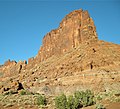| Bridger Jack Butte | |
|---|---|
 Bridger Jack Butte, northeast aspect | |
| Highest point | |
| Elevation | 6,196 ft (1,889 m) [1] |
| Prominence | 322 ft (98 m) [1] |
| Parent peak | Cotton Benchmark (6,747 ft) [2] |
| Isolation | 1.62 mi (2.61 km) [2] |
| Coordinates | 38°05′18″N109°36′02″W / 38.08825°N 109.60042°W [3] |
| Geography | |
| Country | United States |
| State | Utah |
| County | San Juan |
| Protected area | Bears Ears National Monument |
| Parent range | Colorado Plateau |
| Topo map | USGS Harts Point South |
| Geology | |
| Rock age | Late Triassic |
| Rock type | Wingate Sandstone |
| Climbing | |
| First ascent | 1983 |
| Easiest route | Wild Flower class 5.10+ climbing [2] |
Bridger Jack Butte is a sandstone butte located in Bears Ears National Monument, in San Juan County, Utah, United States. Set at the northern tip of Bridger Jack Mesa and above the confluence of Indian and Lavender Creeks, the summit rises to an elevation of 6,196 feet (1,889 meters), and towers over 700 feet (210 meters) above the surrounding terrain and floor of Lavender Canyon to its west. [4] This landmark is situated four miles southeast of the Sixshooter Peaks, and is visible from State Route 211 between Newspaper Rock and the Needles District of Canyonlands National Park. "Bridger Jack" was a Paiute medicine man. [5]









